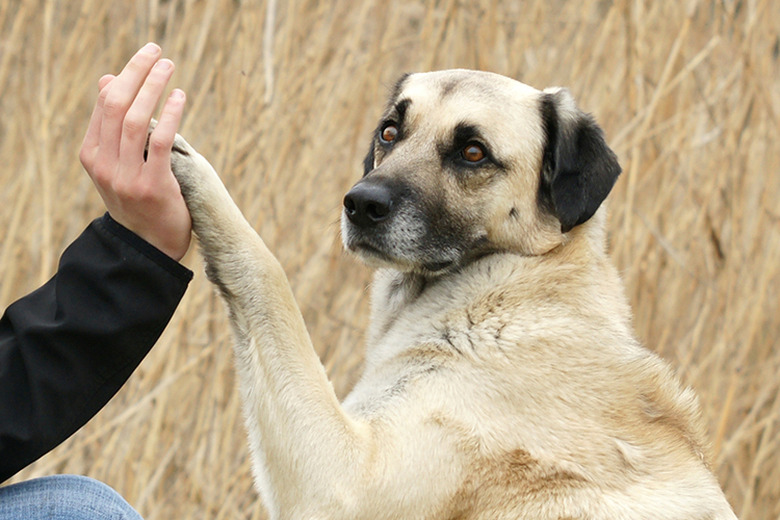Ways Dogs Communicate With Their Paws
Dogs are social animals and have a range of methods for communicating with those around them. Howling and barking are common modes of communication, but they also use body language, including pawing, to communicate. Some paw movements are instinctive while other paw movements are learned, such as scratching at the door to be let out. Examining the context of the pawing and the associated body language and behavior will reveal the likely meaning.
"I Want That"
If you've ever teased a dog by hiding a treat in your hand, you are probably familiar with this type of communication. A dog who paws at an object or hand is trying to get access to it. Over time, your dog will learn that pawing at something he wants results in him receiving it.
"Let's Play"
A dog who is displaying high energy, alert posture and is pawing at you is trying to instigate play. He's saying "hey, chase me." Your dog may also "bow" in order to instigate play. While his meanings are friendly, it's important that your dog doesn't get into the habit of pawing at people to play because he may accidentally hurt someone. What is funny or cute to you may be painful or scary for a small child.
"Pay Attention to Me"
If you're reading, watching TV or doing something that doesn't involve your dog and you feel a paw on your leg, it's because he wants attention. If you react by giving your dog the attention he craves, you reinforce this behavior and encourage your dog to repeat it. Once he's learned this habit, it's hard to stop him from repeating it. For this reason, never respond to being pawed by giving in and lavishing attention on the dog. Instead, ignore the pawing and instigate the interaction with the dog when he becomes passive.
"You're the Boss"
Pawing is also a submissive gesture. When combined with other submissive body language, such as exposing the belly and avoiding eye contact, your dog is saying "I'm not a threat."
"I'm the Boss"
Your dog can use his paws to boss people and other dogs around. By putting his paws on the shoulders or back of another dog, he's telling that dog that he's in charge. If he tries the same thing with you or a family member, you should correct him firmly by pushing him down and saying "no." Your dog should never feel superior to any human in the household.
"I Want to Go Out"
Dogs don't understand the mechanics of hinges and locks, but they do learn very quickly that when they paw at the door, the door opens. This is because most owners interpret the pawing as a sign that the dogs wants to go out, so they open the door for the dog.
By Simon Foden
References
ASPCA: Canine Body Language
Purina: Attention Seeking Dogs
Joyce Fay: Dominant Dogs
About the Author
Simon Foden has been a freelance writer and editor since 1999. He began his writing career after graduating with a Bachelors of Arts degree in music from Salford University. He has contributed to and written for various magazines including "K9 Magazine" and "Pet Friendly Magazine." He has also written for Dogmagazine.net.
